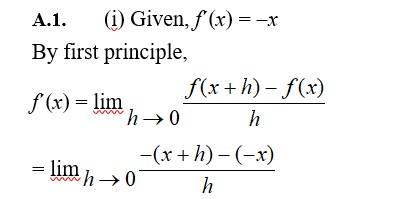Class 11th
Get insights from 8k questions on Class 11th, answered by students, alumni, and experts. You may also ask and answer any question you like about Class 11th
Follow Ask QuestionQuestions
Discussions
Active Users
Followers
New answer posted
6 months agoContributor-Level 10

= - 1.
(ii) Given, f(x) = (-x)-1
by first principle,
f(x)

(iii) Given, f(x) = sin(x + 1)
By first principle,
f'(x) =
= cos (x + 1)
(iv) Given, f(x) = cos
By first principle,
f(x) =

New answer posted
6 months agoContributor-Level 10
. (i) f(x)=sin x cos x
So,
So,
(iii) Given f(x)=5 sec x+4 cosx.
So,
(v) Given,f(x)=3 cot x+5cosecx.
So,
New answer posted
6 months agoContributor-Level 10
(i) f(x)=sin x cos x
So,
So,
(iii) Given f(x)=5 sec x+4 cosx.
So,
(v) Given,f(x)=3 cot x+5cosecx.
So,
New answer posted
6 months agoContributor-Level 10
41. (i)
=2.
(ii) Given, f(x)=
So,
=
(iii) Given, f(x) =
So,
(iv) Given, f(x)=
=
(v) Given, f(x)=
So,
(vi) Given, f(x)=
So,
New question posted
6 months agoNew answer posted
6 months agoContributor-Level 10
14. Let A(x1, y1, z1) and B(x2, y2, z2) trisect the line segment joining the points P(4, 2, –6) and Q(10, –16, 6).
Since A divides PQ internally in ratio 1 : 2. Then co-ordinates of A
=
=
=
= (6, –4, –2)
Similarly B divides PQ internally in ratio 2 : 1. Then co-ordinates of B
=
=
=
= (8, –10, 2)
Hence the points which trisects the line segment joining the points P(4, 2, –6) and Q(10, –16, 6) are (6, –4, –2) and (8, –1)
Taking an Exam? Selecting a College?
Get authentic answers from experts, students and alumni that you won't find anywhere else
Sign Up on ShikshaOn Shiksha, get access to
- 65k Colleges
- 1.2k Exams
- 679k Reviews
- 1800k Answers
